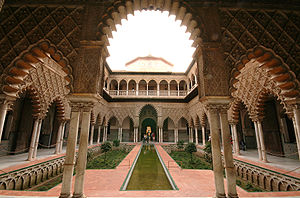Alcázar of Seville
This article needs additional citations for verification. (February 2013) |
| UNESCO World Heritage Site | |
|---|---|
 The Courtyard of the Maidens | |
| Criteria | Cultural: i, ii, iii, vi |
| Reference | 383 |
| Inscription | 1987 (11th Session) |
The Alcázar of Seville (Spanish "Reales Alcázares de Sevilla" or "Royal Alcazars of Seville", Spanish pronunciation: [alˈkaθar])) is a royal palace in Seville, Spain, originally a Moorish fort. It is the oldest royal palace still in use in Europe, and it was registered in 1987 by UNESCO as a World Heritage Site, along with the Seville Cathedral and the General Archive of the Indies.[1]

The Almohades were the first to build a palace, which was called Al-Muwarak, on the site of the modern day Alcázar. The palace is one of the best remaining examples of mudéjar architecture. Subsequent monarchs have added their own additions to the Alcázar. The upper levels of the Alcázar are still used by the royal family as the official Seville residence and are administered by the Patrimonio Nacional.

Sections
Patio de las Doncellas
The name, meaning "The Courtyard of the Maidens", refers to the legend that the Moors demanded 100 virgins every year as tribute from Christian kingdoms in Iberia. The story of the tribute was used as a myth to bolster the Reconquista movement.

The lower level of the Patio was built for King Peter I and includes inscriptions describing Peter as a "sultan". Various lavish reception rooms are located on the sides of the Patio. In the center is a large, rectangular reflecting pool with sunken gardens on either side. For many years, the courtyard was entirely paved in marble with a fountain in the center. However, historical evidence showed the gardens and the reflecting pool were the original design and this arrangement was restored. However, soon after this restoration, the courtyard was temporarily paved with marble once again at the request of movie director Ridley Scott. Scott used the paved courtyard as the set for the court of the King of Jerusalem in his movie Kingdom of Heaven. The courtyard arrangement was converted once more after the movie's production.
The upper story of the Patio was an addition made by Charles V. The addition was designed by Luis de Vega in the style of the Italian Renaissance although he did include both Renaissance and mudéjar plaster work in the decorations. Construction of the addition began in 1540 and ended in 1572.
Los Baños de Doña María de Padilla
The "Baths of Lady María de Padilla" are rainwater tanks beneath the Patio del Crucero. The tanks are named after María de Padilla, the mistress of Peter the Cruel.

La Casa de Contratación
The Casa de Contratación (House of Trade) lies off the la Monteria. It was built in 1503 by the Catholic Monarchs to regulate trade with the New World colonies. The Casa dealt with trade related legal disputes on trade with the Americas. The "Casa" includes a chapel where Columbus met with Ferdinand and Isabella after his second voyage. The chapel houses The Virgin of the Navigators, one of the first paintings to depict the discovery of the Americas and one of the earliest paintings to depict Columbus.
Other sections
- Patio de las Muñecas
- Patio de la Monteria
- Puerta del León
- Dormitorio de los Reyes Moros
- Salón de Embajadores, 1427
History

The palace was the birthplace of Infanta Maria Antonietta of Spain (1729-1785), daughter of Philip V of Spain and Elisabeth Farnese. The king was in the city to oversee the signing of the Treaty of Seville (1729) which ended the Anglo-Spanish War (1727).
References
- ^ "Cathedral, Alcázar and Archivo de Indias in Seville". UNESCO. Retrieved 2009-06-01.
External links
- Ibn Khaldun. The Mediterranean in the 14th century: Rise and fall of Empires (Exhibition at the Alcázar)
- Images of the Alcázar in Seville - 105 images with good descriptions of the Alcázar and its history.
- Casa de la Contratación - in depth historical article.
- El Real Alcázar de Sevilla (In Spanish, English and French)



